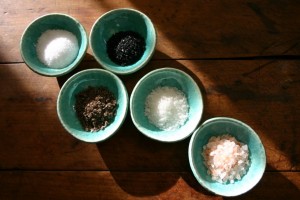 Here are some basic facts about salt:
Here are some basic facts about salt:
All salt comes from the sea – underground mines and seawater. Underground salt deposits were established by ancient seas that dried up. Some of the deposits were thrust upward by geologic forces and are near the surface in the shape of domes. Other deposits lie below ground and need to be mined.
Rock salt is removed by machines within caverns carved into the salt. It is not suitable for food use because the water trapped mud and waste when they dried up. Food grade salt is made by forcing water down a shaft to dissolve salt, forcing the salt water to the surface. It is then cleaned, removing impurities. This is the basis for creating table salt in your salt shaker. In coastal regions, salt is obtained by permitting sunshine and wind to evaporate the water from shallow ponds of seawater.
Most common brands are iodized (contains potassium iodide) in order to counteract goiter (enlargement of thyroid gland) and due to this procedure, this condition has nearly disappeared in North America. My concern is with the other ingredients that are added to table salt to maintain its pure white colour and prevent moisture absorption: dextrose, sodium silico, aluminate, sodium and magnesium carbonate and yellow prussiate of soda.
Read your labels! Kosher salt is more coarsely ground than the other table salts and does not contain any of the above additives. Different shapes and sizes of salts will melt at different rates on the tongue and explain why a teaspoon of one type may weigh half as much as another.
There are gray and pink sea salts from France and Korea, black sea salt from India. They owe their colour to local algae and clay in their evaporation ponds. Salt processed by solar dehydration is supposed to retain a higher level of other minerals, but unless the processing method is mentioned on the package, there is no way to know!
My favourite sea salts are the ones harvested from the coastal waters of Southern Brittany (France). They are sold in several ways, Gros sel (big salt) and sel gris (gray salt). But the best sea salt to garnish your meal is the Fleur de sel (flower of salt). They form on the surface of the ponds when the wind and sun are in harmony. These delicate crusts of crystals must be carefully hand skimmed from the surface, and as a result are very expensive.



